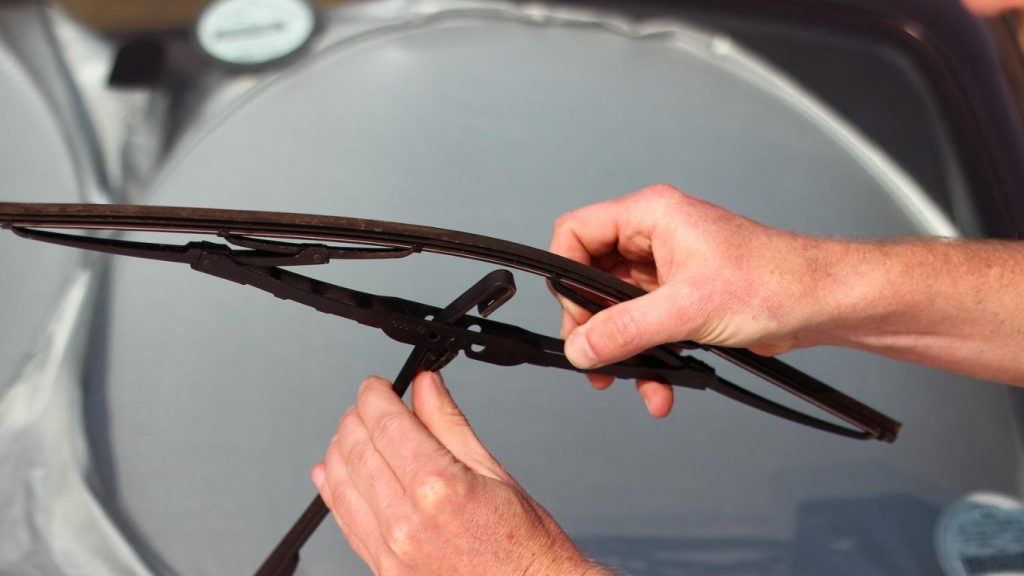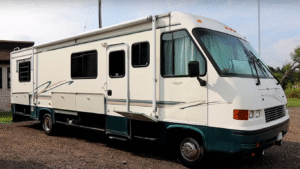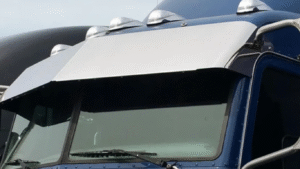Imagine driving in heavy rain, and suddenly, your windshield wipers start leaving streaks, making it nearly impossible to see the road ahead. Or picture a winter morning when your old wipers barely clear the frost, forcing you to squint through a blurry windshield. It’s frustrating, right? But more importantly, it’s dangerous.
Windshield wipers are one of those car parts that don’t get much attention—until they stop working properly. Yet, they play a crucial role in keeping you safe on the road by ensuring clear visibility in rain, snow, dust, and even light fog.
Why windshield wipers are important for safety and visibility
Visibility is the most important factor in safe driving. According to the National Highway Traffic Safety Administration (NHTSA), poor visibility contributes to thousands of accidents every year. Here’s why properly functioning wipers matter:
- Clear Vision = Faster Reaction Time: A clean windshield allows your eyes to process road conditions quickly, giving you more time to react to sudden stops, pedestrians, or obstacles.
- Prevents Light Distortion: A worn-out wiper can leave streaks and smudges, which can cause light glare from streetlights or headlights, making night driving riskier.
- Removes Road Debris: Windshield wipers help clear mud, bugs, and dirt, which, if left untreated, can reduce visibility even in dry weather.
Weather Protection: Rain, snow, and sleet can obstruct your view instantly. Without good wipers, your visibility can go from 100% to nearly zero in seconds.
What Happens If You Ignore Bad Wipers?
Many people delay replacing their windshield wipers, thinking it’s a minor issue. However, neglecting wiper maintenance can lead to:
- Increased risk of accidents due to impaired visibility.
- Scratched windshields if the rubber wears out and exposes the metal frame.
- Unexpected driving hazards in sudden downpours or snowstorms.
- Over time, these scratches can develop into chips, which may require repair. Learn more about how to fix a chipped windshield before the damage worsens.
Why Replace Your Windshield Wipers?
You wouldn’t drive with blurry glasses, right? Then why risk poor visibility with worn-out windshield wipers? Changing wiper blades isn’t just about convenience—it’s about safety.
Worn wipers reduce visibility in rain, snow, and fog, making it harder to see the road. Experts recommend replacing them every 6 to 12 months to ensure a clear windshield and safer driving.
How Do You Know It’s Time for a Windshield Wiper Replacement?
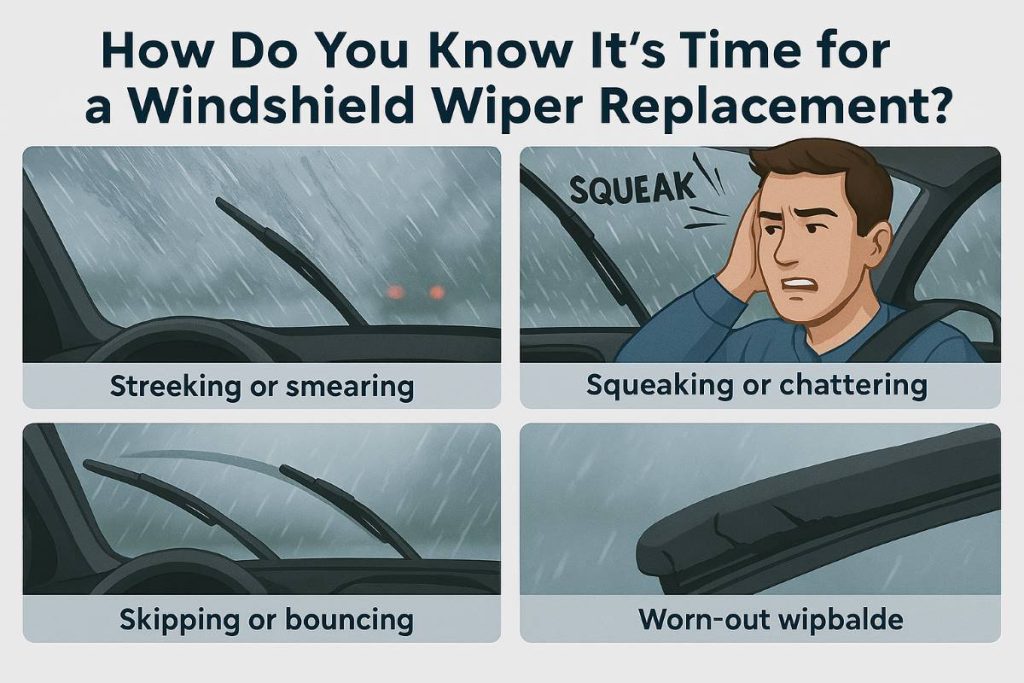
Not sure if your wipers are worn out? Here are the telltale signs:
- Streaks or Smudges – If your wipers leave lines on the glass, they’re not making proper contact.
- Squeaking or Chattering – A noisy wiper means the rubber is dry or damaged.
- Skipping or Bouncing – Wipers that don’t glide smoothly indicate worn-out rubber.
- Visible Cracks or Tears – If the rubber is splitting, it’s time to change windshield wiper blades.
Ignoring these signs can lead to blurred vision and increased accident risk. How do you replace windshield wiper blades? It’s easier than you think—let’s go step by step.
Step-by-Step Guide: How to Change Windshield Wipers
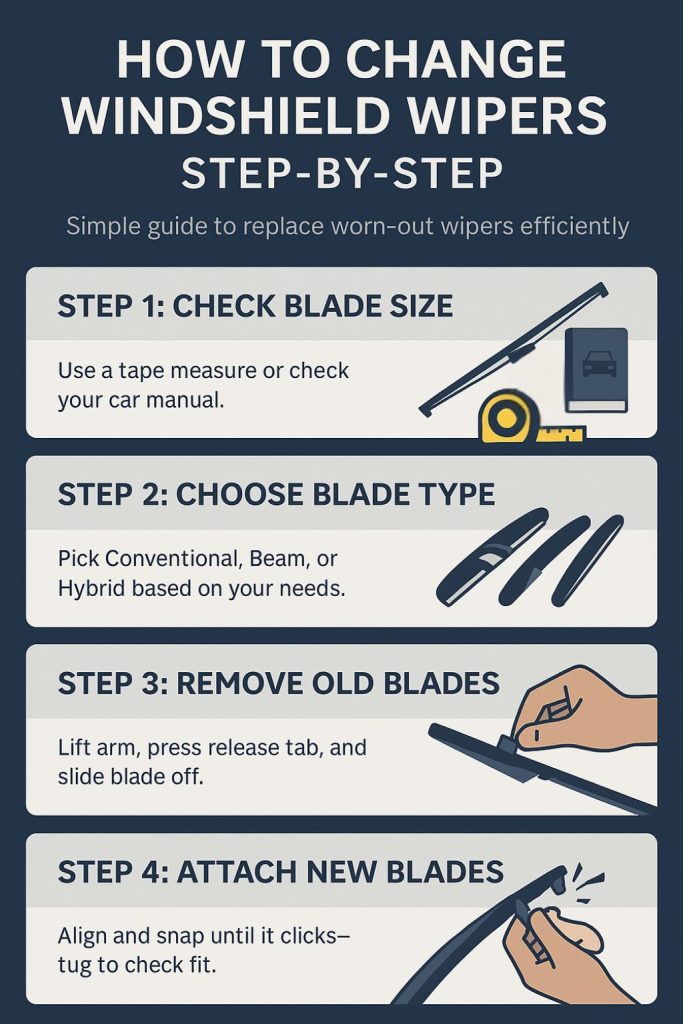
If your wipers are leaving streaks or making noise, it’s time for a windshield wiper replacement. Follow these simple steps to change your wiper blades efficiently.
Step 1: Determine the Blade Size
Before changing windshield wipers, you need to get the correct size.
- Check your owner’s manual or measure the existing blades.
- Some wiper blades have the size printed on them.
- You can also ask an auto technician or check online databases from retailers like Kelley Blue Book for the right fit.
Tip: Learn more about how windshield wiper sizes are measured and why some cars have different-sized wipers for better visibility.
Step 2: Choose the Right Wipers
Not all wiper blades are the same. There are three common types:
- Conventional Blades – Affordable, metal-framed wipers with a rubber strip.
- Beam Blades – More durable, flexible rubber design for better contact with the windshield.
- Hybrid Blades – A mix of both, offering stability and flexibility.
Tip: Get insights on the best wiper blades for your car and which type works best for different weather conditions.
Step 3: Remove the Old Wipers
- Lift the wiper arms away from the windshield carefully.
- Identify how your wiper blades are attached (hook, pin, or side lock).
- Press the release tab and slide the old wiper blade off.
Tip: For a detailed removal guide, check expert recommendations from J.D. Power on how wipers are connected in different car models.
Step 4: Attach the New Wiper Blades
- Align the new wiper blade’s connector with the wiper arm.
- Snap it securely into place—you should hear a click.
- Give it a gentle tug to ensure it’s locked in position.
Step 5: Test the Wipers Before Driving
- Lower the wiper arms gently back onto the windshield.
- Turn on your wipers to check movement and ensure no streaks or noise.
- If possible, spray water on the windshield to simulate rain and confirm smooth operation.
Tip: Experts at Cars.com recommend testing your wipers before a storm hits to avoid visibility issues on the road.
Common Mistakes to Avoid When Changing Windshield Wipers
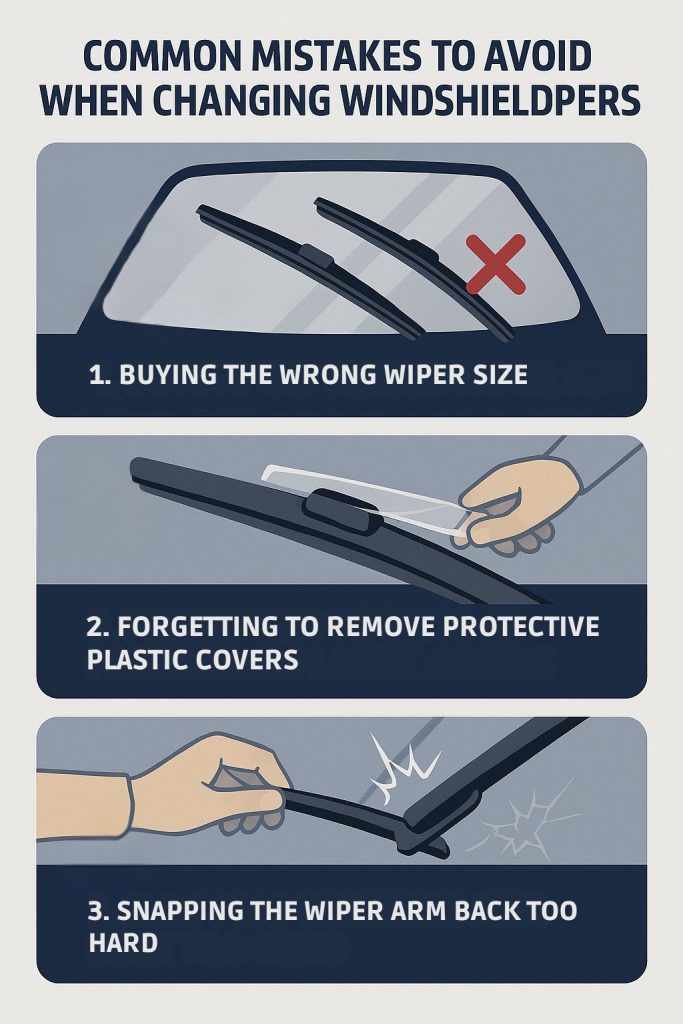
Replacing windshield wipers is simple, but a few common mistakes can lead to poor performance or even windshield damage. Here’s what to watch out for:
1. Buying the Wrong Wiper Size
Not all wipers are the same size. Always check your car’s manual or measure your existing wipers before purchasing. Using the wrong size can cause poor wiping coverage or wipers that don’t fit properly.
2. Forgetting to Remove Protective Plastic Covers
Some new wiper blades come with a thin protective film over the rubber. If you don’t remove it, the wipers won’t make proper contact with the windshield, leaving streaks behind.
3. Snapping the Wiper Arm Back Too Hard
Wiper arms are spring-loaded. If you accidentally let them snap back, they can hit the windshield with force and cause cracks. Always lower them gently after installing the new blades.
Avoiding these simple mistakes ensures your wiper blade replacement goes smoothly and your windshield stays clear.
If your windshield already has a small crack, it’s crucial to prevent it from spreading to maintain clear visibility. Discover effective methods on how to stop a windshield crack from spreading.
Frequently Asked Questions
Yes, some wipers allow you to replace only the rubber strip instead of the whole blade. However, it can be tricky to install, and not all models support this option. Many drivers find it easier to replace the full wiper blade assembly.
Higher-end wipers often last longer and provide better performance, especially in harsh weather conditions. Brands like Bosch, Rain-X, and Michelin use advanced materials that resist wear and tear better than generic or budget options.
Not always. Some vehicles have different-sized wipers for the driver and passenger sides to maximize windshield coverage. Always check your car’s manual or measure the blades before buying replacements.
Yes, winter wiper blades are designed with a rubber casing that prevents ice buildup, making them more effective in snow and freezing conditions. Standard wipers can freeze and become less effective in cold weather.
Legally, most places require functional windshield wipers for safety reasons. Driving without them in bad weather can significantly reduce visibility and increase accident risk.
It’s not recommended. Many glass cleaners contain ammonia, which can dry out the rubber on wiper blades, causing them to crack and wear out faster. Instead, use a damp cloth with mild soap and water to clean them.
If new wipers leave water spots, it could mean your windshield is dirty or has a wax buildup. Try cleaning the windshield with a vinegar-water solution or a dedicated glass cleaner to improve wiper performance.
Yes, if the rubber wears down completely, the metal part of the wiper can scratch the glass. That’s why it’s important to replace your wipers regularly before they get too worn out.
